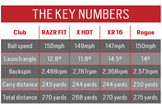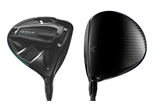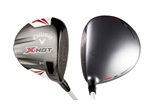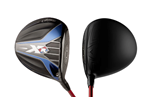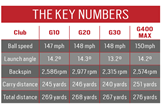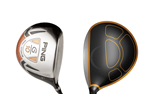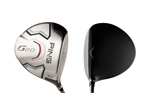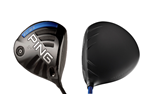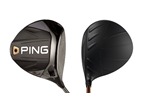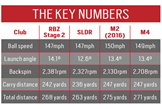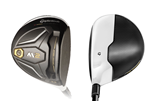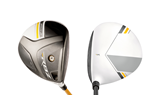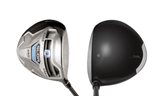TESTED: Old vs New drivers
Published: Last updated:
Adam Scott rocked up to the recent Players Championship in Florida with an eight-year-old driver.
That’s right, a 13-time PGA Tour winner – with over $47 million in the bank – thought his best golf driver option was a Titleist 910 D3, which launched in 2010. You could pick one up today on Golfbidder for £61.
Scott hit eight of 14 fairways in the first round at Sawgrass, and averaged 297 yards off the tee (a decrease of seven yards against his tour average), which got us thinking: Just how different is the latest gear compared to what was available a few years ago? So we called Golfbidder, the UK’s leading supplier of used golf clubs, and asked them to send us the most popular drivers from TaylorMade, Callaway and Ping of the last 10 years. Then we put them up against the latest models…
How we did it:
We took the Golfbidder used drivers (all of which came in 9.5° lofts, or as close as possible) to our test centre at The Belfry. There we took the shafts out and got our TG test pro Ben Frost to hit each club, with a shaft suited to him against each brand’s leading 2018 model, on a launch monitor. Once we’d hit all 12 drivers we analysed the numbers to see how each performed.

TaylorMade’s drivers have changed radically in the timeframe we’re looking at.
From the RBZ Stage 2, with its white crown, to the silver SLDR and the carbon-crowned M2 and M4, each one has revealed new tech that promised more distance and extra forgiveness – but which ones actually delivered?
Review: TaylorMade RBZ Stage 2 driver

Original RRP: £249 Price now: From £108 at Golfbidder.co.uk Launched in: 2013
THE TECH STORY:
Lower more forward CG position: Increases ball speed and reduces spin for extra distance.
Reduced titanium crown thickness: From 0.6mm to 0.4mm removing inefficient mass.
Geometric crown decals: Helps improve alignment.
Until the RBZ Stage 2 arrived, adidas (TaylorMade’s then owners) had seen a steep upwards trajectory in sales. But their philosophy of launching new model after new model was never a long-term strategy. Right when the RBZ Stage 2 hit the market the idea of new drivers being outdated within six months wore a bit thin, and the Stage 2’s geometric crown design was just a step too far.
Low and forward weighting appeared for the first time, creating high launch with low spin, a message used for virtually every major driver launch today. Incredibly, we still reckon it’s a great-looking driver, even though its footprint is smaller. After five years of advancements it was still capable of getting our pro within three yards of a modern TaylorMade driver.
Review: TaylorMade SLDR 460 driver

Original RRP: £369 Price now: From £87 at Golfbidder.co.uk Launched in: 2013
THE TECH STORY:
Low/Forward weighting: Gives a high launching, low spinning ball flight for more distance.
‘Loft Up’: In theory, more loft should help golfers hit straighter drives.
Sliding shot bias weight: Helps dial in a shot shape.
Everything you need to know about getting the right shaft weight
The SLDR represented some seriously different thinking from TaylorMade. It was the first driver to go all-out for low-forward weighting (to deliver high launch with low spin), and it also showcased a sliding weight, rather than just moveable weights. The message with the SLDR was to “Loft Up”, because TaylorMade knew the SLDR wasn’t the most forgiving driver they’d ever made.
Our pro’s numbers back up the thinking completely. If low and forward weighting suits your game (generally quicker swing speeds with an attack angle less down on the ball) the SLDR is an awesome driver (it launched lower than any other driver we hit so robbed our pro of carry distance). But for those it doesn’t fit, it’s a pretty unforgiving temperamental beast, which can nose-dive shots out of the air.
Does TwistFace work? Three testers put it to the test.

Review: TaylorMade M2 (2016) driver

Original RRP: £329 Price now: From £171 at Golfbidder.co.uk Launched in: 2016
THE TECH STORY:
Carbon crown: Frees up inefficient mass high in the head.
Aerodynamic head: Improves airflow over the head, improving club speed.
Speed pocket: Helps retain ball speed on off-centre hits.
No executive at TaylorMade could have imagined the success of the original M2; it’s the driver that turned things around at TaylorMade. It went down a storm on Tour, too. Rory, Justin Rose, Sergio Garcia and Tiger Woods all swore by it, and looking at our data it’s just as good today as it was two years ago.
Half the amount of back weight (22g compared to 41g in M4) is a brilliant set-up for lots of golfers. It’s the driver that put carbon crowns centre stage and showcased (via a complicated internal strengthening rib structure) just how complex modern driver designs have become. Our data shows that thanks to spinning less (our test pro used the same shaft in all four TM drivers) it was tough to beat… and that’s why Tiger Woods played it, even when a newer model was available last year.
Review: TaylorMade M4 driver

Current RRP: £369 Launched in: 2018
THE TECH STORY:
Twist Face: Helps correct golfers’ most common misses from the high toe and low heel.
HammerHead Slot: Increases ball speed from a larger portion of the club face.
Carbon crown: Five layers thick, it frees up inefficient mass high in the head.
Full TaylorMade M4 review here
Every time we’ve tested an M4 this year we’ve seen some pretty high spin numbers, which means you need to select your shaft carefully. Our test pro used an Aldila Rogue shaft when hitting both the M2 and M4 and you can see how closely the pair are matched. For us it means if you’ve got the original M2 your driving is in safe hands, and if you’ve already plumped for an M4 it’s a sound option, especially when you throw in how you’re likely to hit an extra fairway or two thanks to the new TwistFace tech.
M4 encompasses everything TaylorMade has learnt about making drivers uber-forgiving and powerful, yet sound and look great. You only get all that knowledge by making and learning from previous models. It’s no wonder world No.1 Dustin Johnson has one in the bag.
See our 2018 drivers test here
VIDEO REVIEW: Ping G400 MAX vs TaylorMade M4 vs Callaway Rogue
The data:

Our verdict:
Our data shows TaylorMade’s drivers of the last five years are closely matched. Gains have been made, but improvements are pretty small. We reckon the biggest advance is in forgiveness, which is better with the latest models thanks to more weight being positioned to influence MOI.
TESTED: The best ball for under £30

Callaway’s fortunes have changed dramatically in the six years since our oldest model (the RAZR FIT) was on sale.
They’re back to number one in the marketplace (depending on where in the world you are and how you look at sales) and that growth, they would argue, has come because they’ve got better products than the competition. In the space of six years all titanium heads have given way to carbon crowns and “Jailbreak” face technology. We know they make a difference – but how much?
Review: Callaway RAZR Fit driver

Original RRP: £329 Price now: From £63 at Golfbidder.co.uk Launched in: 2012
THE TECH STORY:
455cc head: Freed weight to influence shot bias.
Carbon composite crown: Freed up weight and saw Callaway collaborate with Lamborghini.
Movable sole weights: 12g and 2g weights could be swapped to deliver a draw or fade bias.
Callaway went through a tough time before their current CEO Chip Brewer came on board in 2012 and came up with a five-year plan to take them back to the top of the market. For us RAZR was always a bit of a strange name for a product range, which probably explains why it’s long retired.
TaylorMade might have come out all guns blazing about carbon crowns in 2015 (with the M1), but Callaway had been playing with the idea for several years beforehand. The RAZR’s carbon crown was nothing new even at the time, but it was Callaway’s first movable weight driver, which along with the adjustable hosel increased fitting options. Today the head shape, with its soft edges, is a far cry from a sleek modern driver, but our numbers show how evenly matched Callaway’s pre-Jailbreak drivers were.
Review: Callaway X HOT driver

Original RRP: £249 Price now: From £87 at Golfbidder.co.uk Launched in: 2013
THE TECH STORY:
Speed frame: The start of designing drivers as a skeleton structure to remove mass
from undesirable areas.
All titanium head: After years of playing with carbon composite heads it gave golfers the
sound they wanted.
Everything you need to know about getting the right shaft weight
X HOT hit the market right when TaylorMade were riding the crest of a RocketBallz-fuelled wave, and just before speed pockets really became a “thing”. So it could be said X Hot, which had an all-titanium head, was fighting an uphill battle, which is a real shame as even now we loved the look and feel of it.
Our test pro was bowled over by the responsiveness of the Project X V shaft, which speaks volumes about the importance of getting a club you love the feel of, no matter whether it’s new, used or the longest hitting. Even after five years of being beaten around a golf course this X Hot held its own in terms of numbers (just seven yards back from the Jailbreak-equipped Rogue), and our test pro reckoned he’d happily use a driver this old if it generated the same levels of fairway-finding confidence as the X Hot.

Review: Callaway XR 16 driver

Original RRP: £289 Price now: From £123 at Golfbidder.co.uk Launched in: 2016
THE TECH STORY:
Aerodynamics: Improves head speed
R-Moto face: Improves face flex and ball speeds
Titanium crown: At the time Callaway and golfers reckoned it sounded better than Callaway’s earlier carbon composite models.
Just like TaylorMade’s executives were bowled over by M2’s success, Callaway bosses got a massive slap on the back when XR 16 bagged two majors (in the hands of Danny Willett and Henrik Stenson) in 2016.
XR represented their first collaboration with aeronautical giants Boeing in a bid to convince golfers to take speed seriously. The speed step crown created with Boeing is still used on the Rogue today. XR has a noticeably stretched, wide head (from face to back) to not only improve airflow, but raise forgiveness, too.
An all-titanium head, the XR 16 performed exactly as Callaway promised when jailbreak superseded it. It generated just 3mph less ball speed and between five-six yards less carry than the Rogue, which considering the cost of a new driver is actually pretty reasonable.
Review: Callaway Rogue driver

Current RRP: £469 Launched in: 2018
THE TECH STORY:
Jailbreak: Bars behind the face strengthen the head, improving energy transfer to the golf ball, especially good at higher swing speeds.
Carbon crown: Frees up inefficient weight that can be used elsewhere to improve forgiveness.
X Face: A variable thickness face improves ball speeds from a larger area of the face.
Full Callaway Rogue review here
Jailbreak is the driver break-through of the last few years. The numbers speak for themselves – our test pro’s data was right on the money for ball speed, launch angle and carry distance, which ultimately delivered an excellent blend of carry distance and forgiveness.
Callaway obviously learnt from the XR 16, as Rogue’s stretched head shape is very similar and great for protecting ball speed on off centre hits. A carbon fibre crown reduces weight over the XR 16, which means freed-up extra mass is located in a back weight to improve MOI. Jailbreak is costly to produce, which is why these drivers are among the most expensive on the market.
While our test throws up how the original M2 is still a beast of a driver, we reckon in three years time we’ll be saying exactly the same thing about Rogue.
See our 2018 drivers test here
VIDEO REVIEW: Ping G400 MAX vs TaylorMade M4 vs Callaway Rogue
The data:

Our verdict:
For many golfers six yards (carry distance) isn’t enough to warrant splashing out on a new driver, but it’s exactly how much our pro gained jumping from a five-year-old X Hot to the Rogue. We should say the Rogue boasts a much better MOI (forgiveness) performance, though.
TESTED: The best ball for under £30

Viewing all four Ping drivers’ crowns side by side, the picture is much more evolutionary and consistent from family to family than our other line-ups.
Much like reading the architecture of a building it’s possible to spot what’s evolved in each head, and why Ping swears its titanium technology is so advanced that they don’t need carbon crowns or sliding tracks to free up weight to influence spin and shot bias.
Over the years Ping has realised that creating specific models for certain types of golfers is a great way of optimising drivers, and it’s a strategy Callaway and TaylorMade have adopted today. This is the story of how they got there.
Review: Ping G10 driver

Original RRP: £199 Price now: From £49 at Golfbidder.co.uk Launched in: 2007
THE TECH STORY
Lower/deeper CG Over the G2 and G5, which meant improved forgiveness.
Now 11 years old, it’s incredible how the G10 was only Ping’s third mass-market titanium driver after the G2 and G5. Compared to the competition its look and shaping is positively agricultural, especially compared to the sleek G400 Max.The head is tall, but much less wide from face to back than modern drivers.
Adjustable hosels hadn’t been invented in 2007 so we tested the G10 in a regular flex Grafalloy Red (as we couldn’t change the shaft), which probably added a couple extra mph of ball speed and a few extra yards to our numbers.
Because the G10 and G400 launch very similarly (launch and backspin virtually identical) our data gives a great idea how much more efficient head technology has become. Lee Westwood thought it was so good, Ping had to wrestle it out of his hands after two generations of Ping drivers passed him by!
Review: Ping G20 driver

Original RRP: £255 Price now: From £109 at Golfbidder.co.uk Launched in: 2011
THE TECH STORY:
Wide head shape: Improved forgiveness, simply by changing the head shape.
Everything you need to know about getting the right shaft weight
We’ve heard it said more than once about Ping drivers over the years: ‘So what’s changed?’ The G20 is definitely one of those products you need to look pretty closely at to spot the differences.
The head is much wider than the G10 from face to back, a feature that’s been a mainstay of Ping drivers ever since, as it improves forgiveness. There’s no adjustable hosel, so our test pro had no option but to hit the regular flex TFC Tour shaft fitted on our test club, which probably added a little extra to our ball speed and carry distance numbers.
There’s absolutely no external weight tech to speak of. Back in the day G20 had a reputation for sounding really loud (which in part could be down to the balls golfers used back then), but compared to the other drivers we tested it really wasn’t offensive at all.

Review: Ping G30 driver

Original RRP: £299 Price now: From £149 at Golfbidder.co.uk Launched in: 2014
THE TECH STORY:
Turbulators: The first modern driver to openly talk aerodynamics to improve airflow and speed.
Swing specific models: A low spin and draw biased model meant G30 would suit all types of golfers.
Adjustable hosel: Double the number of options over G25.
The driver that brought aerodynamics centre stage and spurred other brands to think seriously about aero tech. G30 broke Ping’s mould – it’s an engineering company, and anyone who knows anything about the Solheim family (who own Ping) knows they would never have come up with the term “Turbulators” themselves.
“Speed for free” is the term Ping likes to throw about when talking aerodynamics, and it’s testament to the company’s engineering R&D that aerodynamics still play a massive role in their latest drivers four years later. G30 also introduced a lower-spinning LS-Tec and slice-busting SF-Tec models, allowing a single driver model to be tailored to different types of golfers. 2mph less ball speed and nine yards less carry distance isn’t bad for a four-year-old driver.
Review: Ping G400 MAX driver

Current RRP: £389 Launched in: 2018
THE TECH STORY:
Dragonfly crown: Frees up inefficient weight
Tungsten back weight: Makes MAX the highest MOI driver on the market.
Enhanced aero package: Maximises head speed for a 460cc driver.
Tuned: Internal strengthening gives a powerful, muted impact sound.
Full Ping G400 MAX Driver review here
The MAX only launched in January, but it’s already seen as the ultimate driver for lots of golfers. The speed-optimised G400 is teamed with an ultimately forgiving 460cc size which boasts a larger MOI than any other driver on the market.
It means Ping can lay claim to the MAX being golf’s most forgiving driver. And it’s not just for hackers either. One of the tour’s longest hitters, Tony Finau, has one in play. The numbers speak for themselves; the G400 MAX is a potent combination of distance and forgiveness which will deliver the goods for lots of golfers.
It’s one of the most well-rounded drivers we’ve ever tested and we can’t think of many golfers who’d be happy to sacrifice 10 yards of carry to game an older Ping model.
See our 2018 drivers test here
VIDEO REVIEW: Ping G400 MAX vs TaylorMade M4 vs Callaway Rogue
The data:

Our verdict:
This is what 11 years of steady driver progress looks like. Many will say the gains aren’t massive (which they aren’t), but comparing G400 Max against the G30 you’re likely to hit a club less into a green, which in the real world when it comes to scoring is substantial.
TESTED: The best ball for under £30
6 things we learned…
1: A well-fitted driver remains a well-fitted driver no matter what its age.
We’ve seen many golfers rock up to reader fitting days with an older but well-fitted driver, who find it more difficult to gain ball speed and distance with a newer model. It doesn’t mean there won’t be gains, but they are likely to be smaller. As long as your swing hasn’t dramatically changed, a well-fitted driver is still a well fitted driver, even after three or four years in the bag.
2: The best driver models will last.
Easier said than done, we know, but if through a bit of research and our help you identify and buy the hottest driver models that combine the ultimate combination of distance with forgiveness, they will stand the test of time.
3: Old drivers were optimised for old balls.
We’re not saying if you use a five-year-old driver you should use a five-year-old ball, but give some thought to the data you create. Golf balls are now typically higher launching and lower spinning. If you used a five-year-old ball with a similarly-aged driver, it’s highly likely the extra spin over a modern ball would rob you of more distance.
4: Give shaft choice your full attention.
By using our test pro’s preferred shaft for each driver (except the two oldest Ping models) we normalised our data, so we essentially tested heads against heads.
Shaft type/profile and weight is really important nowadays, so find out which style of shaft (light, mid or heavy weight at the very least but ideally profile – where the weight’s located – too) suits you, then take the time to search Golfbidder’s stock list, you’re much more likely to get a club that compliments your game.
5: Engineers keep eking out performance.
Granted, our data shows you’re only likely to gain small amounts of extra ball speed and carry distance by going for the latest all singing and dancing drivers, but year on year every major brand is making impressive forward steps. If your driver is well-fitted you might not need look at an updated for three or four years, but if your club’s older than that, it’s really worth upgrading.
6: Benefits to new and used drivers.
The obvious benefit to buying used is getting your hands on a top-performing club at a fraction of the price of a new model. If you buy used, though, make sure you’re comfortable with not getting a slice of the action when it comes to the very latest tech. We’re thinking Callaway’s Jailbreak and TaylorMade’s TwistFace, which certainly has the capability to help you hit a fairway or two or get you a fraction further down the short grass.
Our verdict:

Our test shows there is a difference between the newest and older drivers, albeit that difference might be smaller than most of us would think.
So why, like Adam Scott, would you plump for an eight-year-old driver? We reckon it comes down to confidence. If, by gaming a favourite old driver, you reinstall confidence to your game (even if you’re giving up a few yards), then it’s probably worth it. But for lots of everyday golfers, the decision between using old or new comes down to cost.
If you’re a serious, regular golfer who’s happy to pay to get as far down the fairway as you can, new is your best option. But if you happen to own a three to five-year-old driver that was fitted for you and you still love it, then that’s just fine too, just so long as you’re comfortable giving up a fistful of yards for the confidence it delivers.



